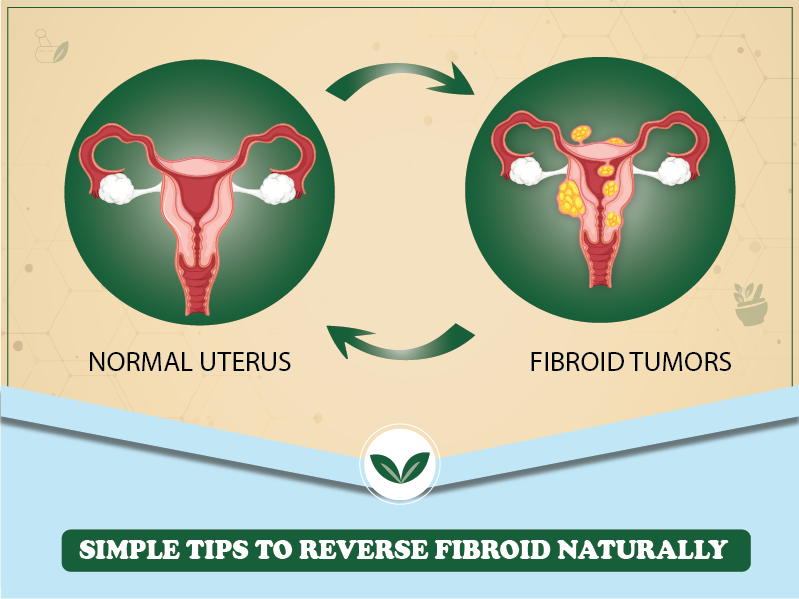
How to reduce the size of Fibroid from 7 cm or more to 0.01 mm or clear completely?
Now you can reduce the risk of miscarriage, heavy bleeding, and pelvic pain naturally with a customized diet, kitchen remedies, and a detox plan
*Safe & Natural* Successfully helped 50,000 plus globally
The fibroid is becoming common in many young women. It is most common for difficulty in conception and even miscarriage.
Fibroids can be as diminutive as a pea and can increase as enormous as a melon.
It is estimated that 20-50% of women have or will have, fibroids at some time in their lives. Most commonly seen in their 30s and 40s, and tend to shrink after menopause.
What is Fibroid?
Fibroid or uterine Fibroid is a benign growth which means a non-cancerous tumor that grows in the uterus (womb).
They grow from the muscle cells of the uterus and may protrude from inside or outside the surface of the uterus, or they may be contained within the muscular wall.
Although they are composed of the same smooth muscle fibers as the uterine wall i.e., myometrium, they are much denser than normal myometrium.
Can Fibroid create a problem in the reproductive system?
Fibroid can develop during a woman’s childbearing years.
These fibroids vary in size, position, and number and thus, cause uterine enlargement.
It is important to understand which size of fibroid is dangerous.
The cause and growth of Fibroid can be hereditary and may also be related to estrogen imbalance.
The growth patterns of uterine fibroids vary. They may grow gradually or rapidly, or they may continue to remain the exact size.
Uterine fibroids are usually round. In most circumstances, fibroids do not induce ache or other symptoms. .
How do I know that I have Fibroid?
Many women with fibroids have no symptoms, while others have symptoms like heavy or painful periods, heavy bleeding between periods, pelvic pain, INFERTILITY, or multiple miscarriages.
Other symptoms include severe pain during sexual intercourse, bloated and heaviness in the lower abdomen, frequent urination.
Fibroid development is influenced by the reproductive hormones estrogen and progesterone.
When these hormone levels reduce at menopause, multiple symptoms of fibroids begin to resolve.
If you notice such symptoms frequently, immediately consult an Ayushakti doctor to treat Fibroid safely and naturally.
Why do Fibroids grow?
Ayushakti Ayurveda believes that the food, when digested, gets converted into different tissues with the help of metabolic fire in a very organized manner.
From the foods digested, nutritional plasma gets absorbed and converted into RASA, which is essential for endocrine harmony.
FSH and LH hormones are produced in the hypothalamus, which is connected with the RASA DHATU.
Then they are brought to the ovaries through blood. Ovaries then make estrogen and progesterone.
Estrogen creates follicles, and progesterone creates menstruation or growth in the baby after conception.
Then the muscle tissues generate the structure of the body, including the uterus and reproductive systems.
When there are blockages in the muscle tissues, it causes multiple growths of tissues.
According to Ayushakti Ayurveda, an Improper diet and Stressful lifestyle vitiate the Tridoshas (Vata, Pitta, Kapha) and Aama (toxins) produced.
The aggravated Doshas, along with Aam, settles in the reproductive channel (Artava-vaha channel) and blocks the metabolic fire causing a complete imbalance in the muscle tissue nourishment.
The vitiated Pitta (heat) causes inflammation in the reproductive channel. It may result in an accumulation of extracellular matrix, collagen, and elastin. It can lead to growth on the muscular wall of the uterus and presents as a Uterine Fibroid.
Improper diet and Stressful lifestyle
Tridoshas aggravation
Vitiated Dosha & Aam pollute of Artava Vaha Stratos
(Uterine Region)
Low metabolic fire
Inflammation in the uterine region
Fibroid growth on the muscular wall of the uterus
UTERINE FIBROID
Other causes include:
- Medications including some types of Antipsychotics, Cancer chemotherapy, Antidepressants, Blood pressure drugs, Allergy medications
- Stress– Mental stress can temporarily alter the functioning of your hypothalamus that controls the hormones that regulate your menstrual cycle. Ovulation and menstruation may stop as an impact.
- Hormonal imbalance like Polycystic ovary syndrome (PCOS), Thyroid malfunction
- Genetic changes
- Other growth characteristics such as insulin-like growth aspect.
Can Fibroid cause infertility?
Fibroids may cause infertility in many different ways
- Compression on the fallopian tubes results in a blockage of the passage of sperm or eggs.
- A large fibroid may distort the pelvic structure and make it difficult for the fallopian tube to capture an egg at the time of ovulation.
- Fibroids in the muscle portion of the uterus may cause reduced blood flow to the uterine lining, making it more difficult for an implanted embryo to grow and develop.
- Even small fibroids in the uterine may cause inflammation that makes the uterine unreceptive for an embryo to implant.
- Some of these same possibilities may also increase the risk of miscarriage.
Can Fibroid cause miscarriage?
Depending on size & position, they interfere in implanting an embryo or even can be responsible for miscarriages.
Book a consultation to treat your fibroid problems
What are the types of Fibroid?
The type of uterine Fibroid depends on its location in or on the uterus.
- Intramural fibroids-
Intramural fibroids are the most typical type of Fibroid. These kinds emerge within the muscular wall of the uterus. Intramural fibroids may expand larger and can extend your womb.
- Subserosal fibroids-
Subserosal fibroids form on the exterior part of your uterus, which is named the serosa. They may expand enormous enough to make your womb seem bigger on one side.
- Pedunculated fibroids-
Subserosal tumors can generate a limb, a slender bottom that helps the tumor. When they do, they’re comprehended as pedunculated fibroids.
- Submucosal fibroids-
These types of tumors develop in the middle muscle layer of the uterus. Submucosal tumors aren’t as ordinary as the other types.
How to diagnose Fibroid?
- Pelvic Exam- Uterine fibroids are often discovered incidentally during a routine pelvic exam. Your physician may feel abnormalities in the shape of your uterus, indicating the presence of fibroids.
- Ultrasound– It utilizes sound waves to obtain a photo of your uterus to verify the diagnosis and to map and gauge fibroids.
- Lab tests- If you have abnormal menstrual bleeding, your doctor may order a complete blood count (CBC) to determine if you have anemia because of chronic blood loss and other blood tests to rule out bleeding disorders or thyroid problems.
- Imaging studies-
- Magnetic resonance imaging (MRI): This imaging examination can demonstrate the length and location of fibroids, recognize different types of tumors, and assist specify suitable treatment options.
- Hysterosonography: It uses sterile saline to expand the uterine cavity, making it easier to get images of submucosal fibroids and the endometrium.
- Hysterosalpingography: It uses a dye to highlight the uterine cavity and fallopian tubes on X-ray images. Your physician may advise it if infertility is a problem. It also can help to determine if your fallopian tubes are open.
- Hysteroscopy- A lighted telescope called a hysteroscope is inserted through the cervix into the uterus. The doctor then injects saline into your uterus, expanding the uterine cavity and allowing the doctor to examine the walls of your uterus and the openings of your fallopian tubes.
Ayushakti’s expert doctors (Vaidya) diagnose Fibroid through pulse reading (personal consultation) or face reading (video consultation). Ayushakti doctor will evaluate the symptoms and accordingly plan a combination of treatments for ultimate reduction in Fibroid Size.
Book a consultation to treat your Fibroid naturally
Will Fibroids go away?
Treatment as per modern science
There’s no single best approach to uterine Fibroid in modern medicines. Many treatment options exist. Your doctor can guide yo









